Customer engagement is no longer a “nice to have” – customers expect brands to engage with them throughout their journey using various methods on different platforms.
The latest figures from Adobe reinforce this sentiment. They found that companies with the strongest omnichannel customer engagement strategies enjoy a 10% annual growth, a 10% increase in average order value, and a 25% increase in close rates.
In this guide, we’ll define customer engagement, why it’s important, and how to measure it. Then we’ll look at some strategies and show you how to boost customer engagement with monday.com.
What is customer engagement?
Customer engagement involves consistently interacting with your customers through different channels to build a stronger relationship and foster brand loyalty. You can engage with customers via social media, email, websites, community forums, or any other platform where they communicate or consume content.
Effective customer engagement requires integrated technology, like a CRM, so teams have a single, 360-degree view of every customer. Using these insights, they can tailor content and experiences to customers’ unique needs and meet their expectations.
According to Salesforce’s State of the Connected Customer survey, 85% of customers expect consistent interactions across departments.
Customer engagement vs. customer experience vs. customer satisfaction
Let’s establish the differences between customer engagement, customer experience, and customer satisfaction.
- Customer experience (CX) is an immersive brand process, from billboard ads to marketing campaigns or in-store culture. The goal is to see your business from your customer’s perspective and deliver an exceptional experience, ideally leading to a purchase.
A study by Oracle revealed that more than one-third (34%) of consumers would never shop with a company again after just one bad experience.
- Customer satisfaction measures how much your customers like a product, service or experience. It determines whether your brand met and exceeded their expectations using quantitative and qualitative data from customer surveys, typically using the Net Promoter Score (NPS).
Why is customer engagement important?
Retaining an existing customer is far less expensive than acquiring a new one.
According to Review 42, acquiring new customers costs 5 times as much as retaining existing ones. And it costs 16 times more to build a long-term relationship with a new customer compared to keeping an existing one.
So it makes sense to keep customers engaged throughout their purchase journey from lead to brand advocate. The more you interact with them, the more insights you can collect and the more you can tailor your messaging and content to their specific needs.
Keeping your customers engaged:
- Boosts brand experience
- Improves customer relationships
- Increases customer loyalty and trust
- Accelerates the sales funnel
- Unearths upsell and cross-sell opportunities
- Provides valuable customer feedback and insights
- Streamlines purchase cycles
- Increases customer satisfaction
- Improves customer experience
What are common customer engagement metrics?
Here are some ways marketing, sales, and service teams can measure customer engagement levels.
Average order value (AOV)
The average order value is the average amount customers spend when purchasing. The higher this metric, the more repeat customers return to your website. Retaining more customers is a sure sign that your engagement efforts are working.
Engagement rate
Engagement rate measures the number of interactions (likes, comments, shares, views, and clicks) a piece of content receives on social media compared to the number of followers an account has.
Engagement Rate = (Interactions / Followers) x 100
For example, a Facebook page with 10,000 followers that receives 200 interactions on a post has an engagement rate of 2%.
Purchase frequency
Purchase frequency shows how often customers purchase your product or service in a given timeframe, like the last 365 days.
Purchase Frequency = Number of orders / Number of unique customers
Knowing how long your average customer takes to make another purchase, you can determine where to ramp up your engagement efforts.
Repeat purchase rate
The repeat purchase rate shows how many customers purchase more than once within a set period.
Repeat Purchase Rate = (Number of customers who made more than one purchase / Total number of customers) x 100
Using the percentage rate, you can determine how effective your customer engagement and retention strategies are.
Email open/click rates
Email marketing campaigns vary according to segmented contacts, so measuring the overall customer engagement rate is not always possible. Consider focusing your metrics on a single campaign that goes to most of your subscribers, like a newsletter. You can measure open and click-through rates and run A/B tests to see which subject lines, content, and links engage customers most.
Web traffic: pages per session
The number of pages a user visits in a single session indicates how helpful and engaging your content is. A high number of pages per session shows customers are interested in your brand and your products. A low number indicates there may be a problem with your content, which you can address accordingly.
Read also: Unlock business insights through customer data analysis
Customer engagement strategies
Here are six ways you can engage your customers.
1. Personalize customer experiences
Customers expect a personalized experience as they progress through the customer journey, from brand awareness to buying and receiving support afterward.
A Salesforce survey found that 56% of customers expect all offers to be personalized. In comparison, Forbes reported that 72% of consumers only engage with personalized marketing messages.
For example, Amazon recommends products based on customers’ past purchases or search history.
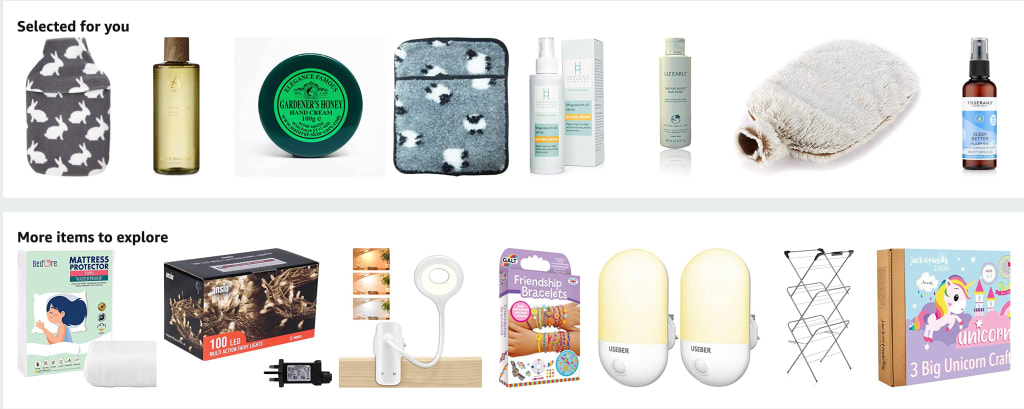
2. Create content based on customer history
Not all personalization has to be based on purchase history. You can also create content based on behavior and preferences.
For example, Spotify lives and breathes customer obsession and creates a “Discover Weekly” playlist for each user based on songs and podcasts they’ve listened to previously. The goal is to engage listeners and help them discover more content they might enjoy.
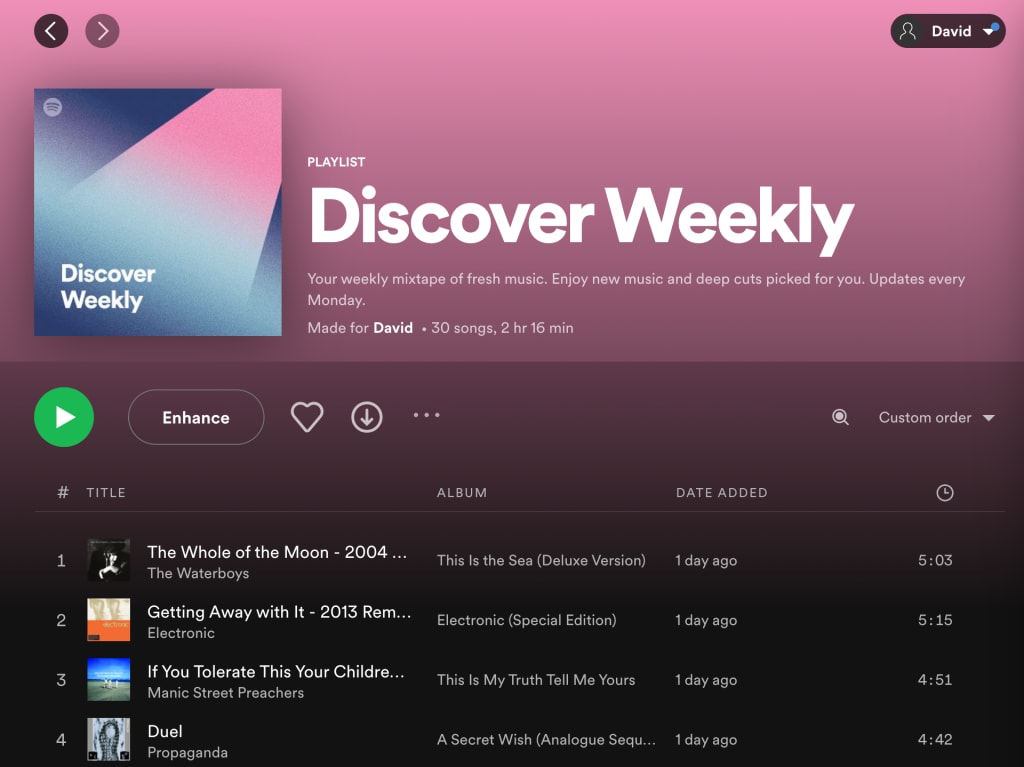
3. Run social media contests
Social media contests and giveaways are a great way to engage new and existing customers. They can drive brand awareness and turn customers into brand ambassadors.
Customers can share, retweet, comment, or tag your brand for a chance to win, and also promote it to their followers. For example, Urban Creek Candle Co ran this holiday giveaway on Instagram.

4. Communicate via the proper channels
Not all customers use social media, so engaging with them on other channels is essential. For example, consider using the following:
- Sending postcards via the mail
- Advertising on TV and radio
- Using billboards in busy pedestrian areas
- Generate a dynamic QR code and place it on public transport and in public spaces
5. Respond quickly
Live chat provides a quick route to engage your customers’ pre and post-sales. For example, WPX uses live chat to answer product queries from potential customers and provide after-sales support and service to existing customers in record time.

6. Build a unified brand voice
More than three-quarters of customers expect a unified brand voice, whether speaking to sales or customer service. That means every department needs access to customers’ historical data so they can engage them accordingly. For example, you could use a CRM software like monday.com to store all customer information and interactions.
How to boost customer engagement with monday sales CRM
It’s essential to have a robust work management platform and CRM to manage customer relationship throughout the lifecycle, and monday sales CRM has the advantage of being both.
Music streaming service Deezer increased customer engagement by 483% in a matter of weeks using monday.com.
Here’s how you can boost customer engagement with monday sales CRM.
Centralize data
monday sales CRM platform centralizes and updates all your customer data in real-time, which is great for pipeline and crm management. It helps sales reps boost customer engagement, enables marketers to create productive campaigns, and aids support agents in replacing generic responses with personalized messages.
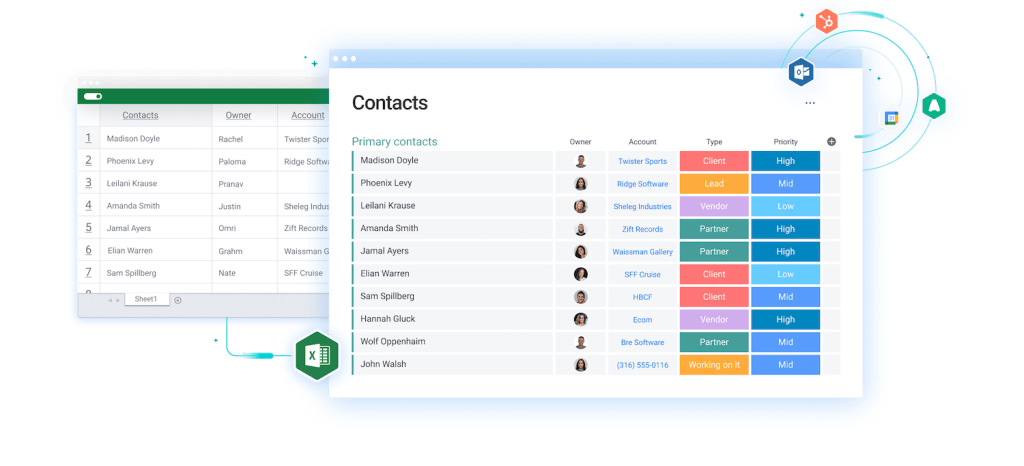
Collaborate across teams
With a single centralized pipeline, everyone can see what other teams are doing, and they can collaborate more, which increases productivity and ensures you engage customers as one.
When Deezer moved to monday.com, they tripled the number of weekly campaigns because it was easier for teams to collaborate in the CRM global pipeline.
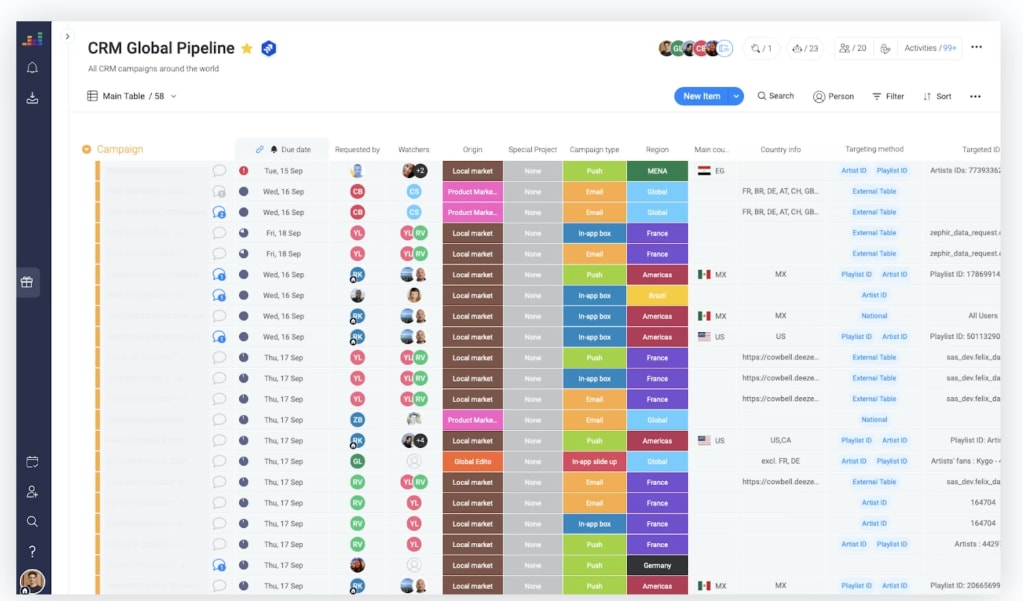
Evaluate leads
Every lead represents a potential sale, but some are more likely to convert than others. Configure monday sales CRM to collect leads from any source into a central hub, automatically score them based on custom criteria, and nurture and engage them accordingly.
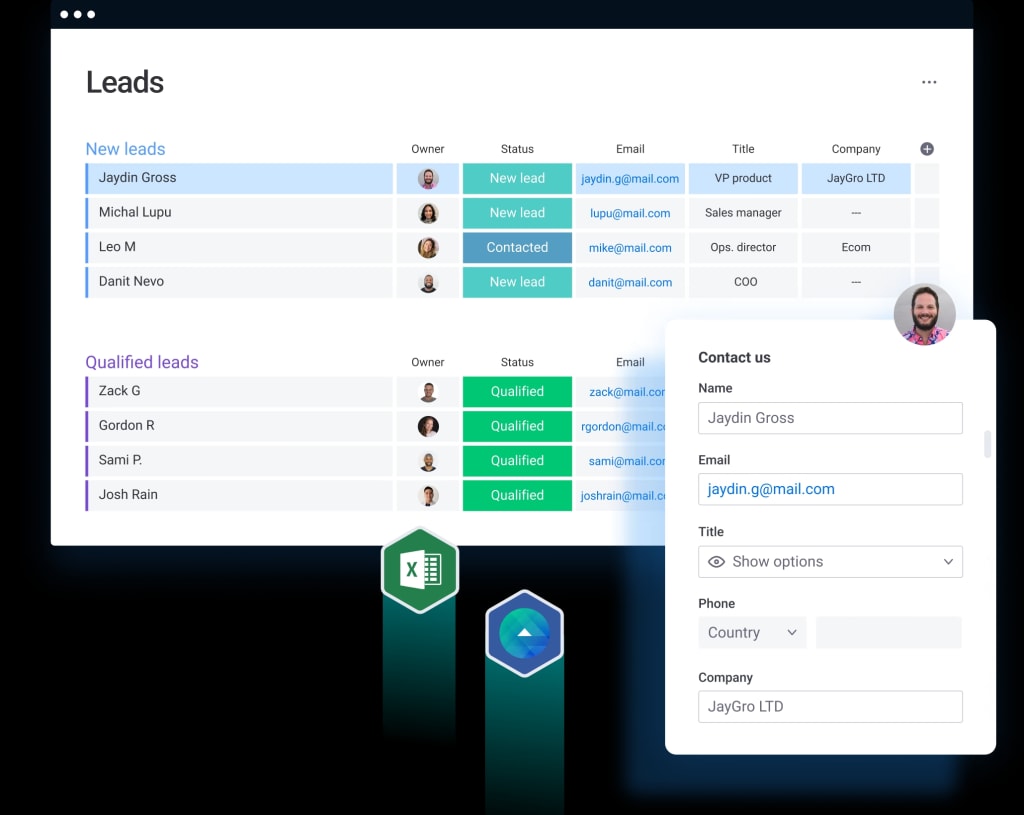
Track campaign performance
With a centralized CRM dashboard, teams can instantly track the results of their campaigns, adjust them accordingly and launch new campaigns to ensure they engage customers.
When Deezer switched their CRM campaigns to monday.com, they increased customer engagement by 483%. Now their users listen to much more music and can find new artists and tracks to enjoy.
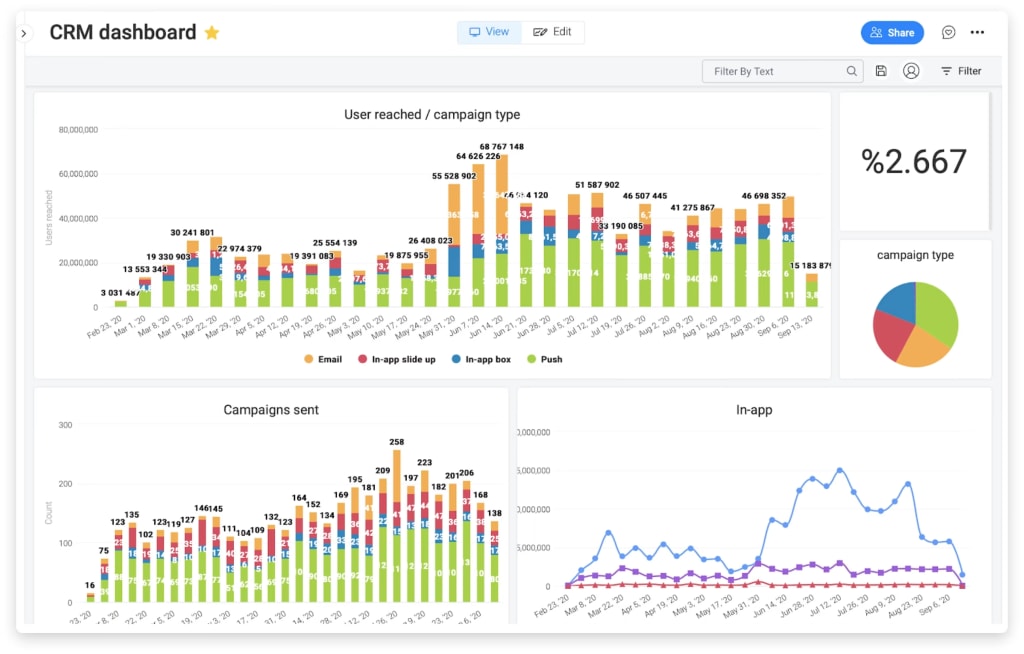
Frequently asked questions
Here are two frequently asked questions about customer engagement.
What is a customer engagement manager?
A customer engagement manager is responsible for creating healthy relationships with customers. They are responsible for interacting with them, addressing their concerns, and acting as their primary point of contact. Additionally, they supervise employees who deal with customers.
What is a customer engagement model?
A customer engagement model is the approach companies take to establish and strengthen customer relationships. A successful customer engagement model will significantly increase trial conversions, customer satisfaction, revenue per customer, and customer retention.
Increase customer engagement with monday sales CRM
Customers expect brands to engage them with personalized content and experiences across various channels, no matter which department they work in. Effective customer engagement requires integrated technology, like a CRM, so everyone has a single 360-degree view of each customer.
Try monday sales CRM to see how easy it is for teams to collaborate and manage customer engagement in a central workspace.

